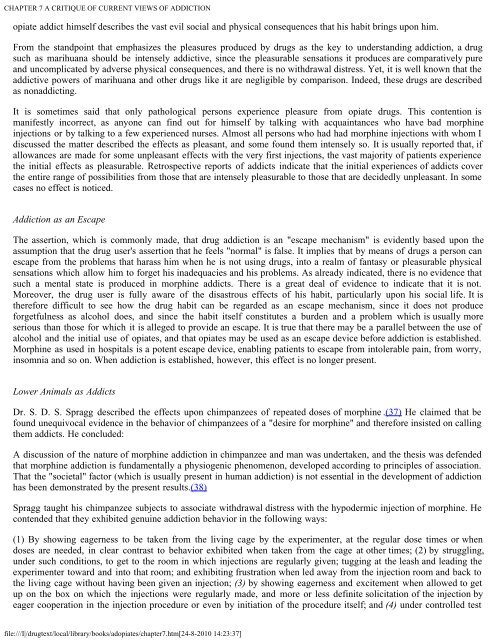Addiction and Opiates
Addiction and Opiates
Addiction and Opiates
You also want an ePaper? Increase the reach of your titles
YUMPU automatically turns print PDFs into web optimized ePapers that Google loves.
CHAPTER 7 A CRITIQUE OF CURRENT VIEWS OF ADDICTION<br />
opiate addict himself describes the vast evil social <strong>and</strong> physical consequences that his habit brings upon him.<br />
From the st<strong>and</strong>point that emphasizes the pleasures produced by drugs as the key to underst<strong>and</strong>ing addiction, a drug<br />
such as marihuana should be intensely addictive, since the pleasurable sensations it produces are comparatively pure<br />
<strong>and</strong> uncomplicated by adverse physical consequences, <strong>and</strong> there is no withdrawal distress. Yet, it is well known that the<br />
addictive powers of marihuana <strong>and</strong> other drugs like it are negligible by comparison. Indeed, these drugs are described<br />
as nonaddicting.<br />
It is sometimes said that only pathological persons experience pleasure from opiate drugs. This contention is<br />
manifestly incorrect, as anyone can find out for himself by talking with acquaintances who have bad morphine<br />
injections or by talking to a few experienced nurses. Almost all persons who had had morphine injections with whom I<br />
discussed the matter described the effects as pleasant, <strong>and</strong> some found them intensely so. It is usually reported that, if<br />
allowances are made for some unpleasant effects with the very first injections, the vast majority of patients experience<br />
the initial effects as pleasurable. Retrospective reports of addicts indicate that the initial experiences of addicts cover<br />
the entire range of possibilities from those that are intensely pleasurable to those that are decidedly unpleasant. In some<br />
cases no effect is noticed.<br />
<strong>Addiction</strong> as an Escape<br />
The assertion, which is commonly made, that drug addiction is an "escape mechanism" is evidently based upon the<br />
assumption that the drug user's assertion that he feels "normal" is false. It implies that by means of drugs a person can<br />
escape from the problems that harass him when he is not using drugs, into a realm of fantasy or pleasurable physical<br />
sensations which allow him to forget his inadequacies <strong>and</strong> his problems. As already indicated, there is no evidence that<br />
such a mental state is produced in morphine addicts. There is a great deal of evidence to indicate that it is not.<br />
Moreover, the drug user is fully aware of the disastrous effects of his habit, particularly upon his social life. It is<br />
therefore difficult to see how the drug habit can be regarded as an escape mechanism, since it does not produce<br />
forgetfulness as alcohol does, <strong>and</strong> since the habit itself constitutes a burden <strong>and</strong> a problem which is usually more<br />
serious than those for which it is alleged to provide an escape. It is true that there may be a parallel between the use of<br />
alcohol <strong>and</strong> the initial use of opiates, <strong>and</strong> that opiates may be used as an escape device before addiction is established.<br />
Morphine as used in hospitals is a potent escape device, enabling patients to escape from intolerable pain, from worry,<br />
insomnia <strong>and</strong> so on. When addiction is established, however, this effect is no longer present.<br />
Lower Animals as Addicts<br />
Dr. S. D. S. Spragg described the effects upon chimpanzees of repeated doses of morphine .(37) He claimed that be<br />
found unequivocal evidence in the behavior of chimpanzees of a "desire for morphine" <strong>and</strong> therefore insisted on calling<br />
them addicts. He concluded:<br />
A discussion of the nature of morphine addiction in chimpanzee <strong>and</strong> man was undertaken, <strong>and</strong> the thesis was defended<br />
that morphine addiction is fundamentally a physiogenic phenomenon, developed according to principles of association.<br />
That the "societal" factor (which is usually present in human addiction) is not essential in the development of addiction<br />
has been demonstrated by the present results.(38)<br />
Spragg taught his chimpanzee subjects to associate withdrawal distress with the hypodermic injection of morphine. He<br />
contended that they exhibited genuine addiction behavior in the following ways:<br />
(1) By showing eagerness to be taken from the living cage by the experimenter, at the regular dose times or when<br />
doses are needed, in clear contrast to behavior exhibited when taken from the cage at other times; (2) by struggling,<br />
under such conditions, to get to the room in which injections are regularly given; tugging at the leash <strong>and</strong> leading the<br />
experimenter toward <strong>and</strong> into that room; <strong>and</strong> exhibiting frustration when led away from the injection room <strong>and</strong> back to<br />
the living cage without having been given an injection; (3) by showing eagerness <strong>and</strong> excitement when allowed to get<br />
up on the box on which the injections were regularly made, <strong>and</strong> more or less definite solicitation of the injection by<br />
eager cooperation in the injection procedure or even by initiation of the procedure itself; <strong>and</strong> (4) under controlled test<br />
file:///I|/drugtext/local/library/books/adopiates/chapter7.htm[24-8-2010 14:23:37]





